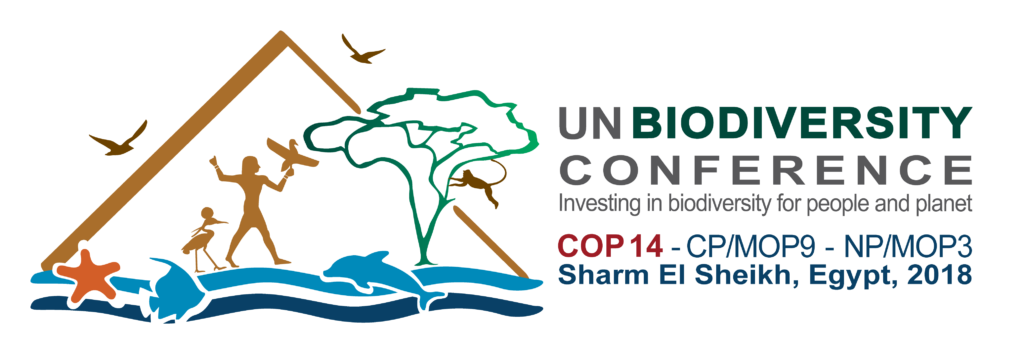
On the 23rd of November 2018 at COP14 of the Convention on Biological Diversity (CBD) in Sharm El-Sheikh, Parties and Observers to the CBD and other biodiversity accords convened experts, practitioners, scholars and stakeholders from law, governance and other fields, in order to scale up efforts to address the main drivers of biodiversity loss, implement the Strategic Plan 2011-2020 and the global Sustainable Development Goals (SDGs) through legal and institutional measures.
The 2018 Biodiversity Law & Governance Day facilitated dialogue, engagement and action between Parties, Observers and stakeholders, including a growing global biodiversity law and governance community of practice. The Centre for International Sustainable Development Law (CISDL) and the Convention on Biological Diversity Secretariat (SCBD), together with the United Nations Development Programme (UNDP), United Nations Environment Programme (UN-Environment), International Union for the Conservation of Nature World Commission for Environmental Law (IUCN-WCEL), International Development Law Organization (IDLO) and other partners were honoured to bring Parties, UN bodies and agencies, intergovernmental organizations, academia, private sector actors and civil society together, building upon the success of the inaugural 2016 Biodiversity Law and Governance Day (BLGD) held in Cancun alongside CBD CoP13. The assembled participants identified trends, shared knowledge and practical experiences, and built capacity for collaborative efforts on mainstreaming biodiversity in energy and mining, infrastructure, manufacturing and processing, and health; implementing the Strategic Plan 2011-2020 and Aichi Biodiversity Targets; strengthening the effectiveness of the Nagoya Protocol; and enhancing synergies between biodiversity treaties and international organizations.
Themes of Biodiversity Law & Governance Day 2018:
- Mainstreaming biodiversity in the sectors of energy and mining, infrastructure, manufacturing and processing, and health:
How can law and governance mechanisms assist in mainstreaming of biodiversity in the sectors of energy and mining, infrastructure, manufacturing and processing, and health? What is the role of environmental impact assessment and strategic environmental assessment? - Implementing the Strategic Plan 2011-2020 and Aichi Biodiversity Targets:
COP 15 in 2020 is expected to consider for adoption the post-2020 global biodiversity framework in the context of the 2050 Vision of the current Strategic Plan, and the 2030 Agenda for Sustainable Development and other relevant international processes. What can be learned from law and governance approaches that have been adopted to implement the current Strategic Plan? What should the role of law and governance be in the post-2020 framework? - Strengthening the effectiveness of the Nagoya Protocol:
The Nagoya Protocol has been in force for nearly four years, and the Parties will undertake the first assessment and review of its effectiveness at COP-MOP 3. What lessons can be learned from national and regional implementation efforts? What will the impacts be of emerging technologies on the effectiveness of the Protocol? - Enhancing synergies between biodiversity treaties and international organizations:
Many international treaties and processes are relevant to biodiversity and ecosystems. How can Parties to the CBD and international organizations improve cooperation so as to enhance synergies and address intersections between organizations and regimes and biodiversity? What law and governance mechanisms can be used to improve coordination and cohesion?
Offering over a full day of dialogue, keynotes, and parallel roundtable/panel sessions, BLGD 2018 stimulated knowledge exchange, built synergies for capacity building and research collaborations, and inspired cross-pollination between different fields of law, policy and jurisdictions to encourage innovation in legal and institutional tools for mainstreaming biodiversity.
In addition, in BLGD 2018, Parties, Observers and other stakeholders and supporters from the global biodiversity law and governance community of practice:
- Profiled and shared innovative international, national, and local biodiversity law and governance mechanisms, challenges and best practices;
- Catalysed knowledge exchange between delegates, legal practitioners and the legal academic community to co-generate new law and governance knowledge and approaches; and
- Facilitated collaboration within the law and governance community to support capacity development for implementing the CBD, the Strategic Plan on Biodiversity 2011-2020, and SDGs 14 and 15.
For more information on BLGD 2018, contact blgd@cisdl.org
THEMES
- Mainstreaming biodiversity in the sectors of energy and mining, infrastructure, manufacturing and processing, and health;
- The conclusion of the Strategic Plan 2011-2020 and Aichi Biodiversity Targets;
- The effectiveness of the Nagoya Protocol; and,
- Enhancing synergies between different biodiversity conventions and international organizations
